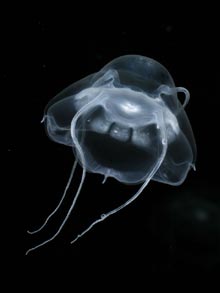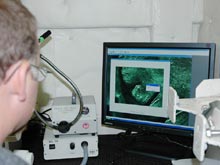
The new jellyfish is in the order Narcomedusae. It has four tentacles, 12 stomach pouches, and most interestingly, four small secondary tentacles at the very edge of the bell. While foraging for food, this species holds its long tentacles, covered with poison filled stinging cells, out in front while it swims, perhaps to ambush its prey more effectively. Click image for larger view.
New Life Forms in Alien Environments
July 5, 2005
Kevin A. Raskoff
Biologist
California State University, Monterey Bay
On the first Hidden Ocean expedition in 2002, we set out to look at the animals that spend their life in the midwaters (not at the surface or the bottom, but in the middle of the sea). These are often bizarre animals, many lacking any hard parts, and are mostly made of gelatinous flesh. We felt like we were exploring alien life forms in the most foreign of all earthly environments, the frozen Arctic Ocean. One of the many interesting things we discovered was a strange, four tentacled jellyfish. We were lucky enough to capture one of these beasts. Although we thought it was a new species, with a sample size of only one we refrained from formally describing the animal in the hopes that more specimens would eventually be found.
We didn't have to wait very long. On the second midwater ROV dive of this expedition, we saw not one, but dozens of these jellies! Skillfully, the ROV pilots we were able to capture and collect five specimens. As the ROV slowly brought our gelatinous bounty up to the surface at the end of our dive, my mind raced. Would they be the same as what we found in 2002? Would they all look the same, or would they show such variation that I still would not understand what 'normal' was for this new jelly?
Traditional taxonomy (the scientific method of naming and classifying living things) is based mostly on what you can see with your own eyes (perhaps aided by cameras or microscopes). It is based on things that you can point to and say, “Look! That's different!” Increasingly in the last few decades, the invisible world of DNA and other molecules are taking on an ever increasing role in taxonomy. But some of the same frustrations still plague molecular taxonomists as well…how much of the measured variation between two things is just the normal plasticity of the species (all humans are not 5'7” with blue eyes), and when do the differences accumulate to a point where we can say that this is one species and this thing over here is another? Unfortunately, there are no magic numbers or error-free methods in these endeavors. We try to understand all that is known about a group so we can recognize when we are seeing something that is outside the expected, something new…like a strange little jellyfish found a mile beneath the frozen seas of the Arctic Ocean.
As I pulled the first specimen from the sampler and hit it with my flashlight beam I held my breath, then I felt a knot loosen in my stomach… I was looking at an old friend. These were indeed the same animals we found in 2002. All the similar characteristics between the specimens were there, all the oddities, different from any other jellyfish known. A new species. Seeing something for the first time is special. You feel obligated to give it a proper introduction to the world. In the months ahead we will officially describe the species and give it a scientific name. One more piece of the puzzle filled. By itself, perhaps it is only a strange jellyfish, but to me it represents all of the reasons we are here in the Arctic, striving to discover and understand this alien sea.
Sign up for the Ocean Explorer E-mail Update List.


































